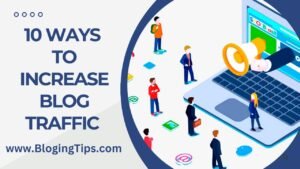Five Blogger Tested Strategies for Increasing Website Traffic, The most recent Google update hit our friends travelers – bloggers – with a hammer. In spite of the challenges posed in this change, we’re impressed by their determination. Although we can’t be able to influence Google but we can control the things that are within our reach.
Five travel bloggers have tested strategies to boost web traffic following the most recent Google update.
In This Guide
1. Use Pinterest As An Additional Search Engine
2. Keep Visitors Engaged With Email Marketing
3. Add Your Content To Flipboard To Grab More Website Visits
4. Get Discovered With Short-Form Videos On Social Media
5. Expose Yourself To New Audiences With Guest Posting
6. Compensate For Traffic Dips By Maximizing Your Revenue.
Maximize the value of every visitor. Read our guide Ten Tips to Maximize Profit from Travel Bloggers.
1. Use Pinterest As An Additional Search Engine

A lot of people view Pinterest as an online social media platform However, it actually functions than that. It is a search engine..
The Pinterest’s tools provide a great method to attract customers to your website.
How To Get Started With Pinterest
Create a brand new business account or link/convert an existing private account in order to collect access to company tools such as Pinterest Business Hub and Pinterest Analytics that allow users to keep track of searches and search terms.
Create a captivating biography for the profile you’re creating. If you have niche terms you’re together on your website add them here.
Claim your website and allow you to monitor when people share your site’s material via Pinterest. In addition it will automatically add your Pinterest profile and a “follow” button, allowing you to get more people to visit your website.
How To Use Pinterest Like A Pro
Pinterest is built on pictures and so having great images is essential. It is important to make your website be noticed on your web.
While traveling, take numerous photos and select those excellent photos later.
Utilize design tools such as Canva to include text, create intriguing designs, and even add branding elements.
Create boards that arrange the material by categories like by location or type of blog post.
Like every other search engine it is important to conduct keyword research for Pinterest. Make use of professional tools such as Pinterest Trends, which lets you know the volume of searches for keywords and the pins that are most popular for them.
Utilize your keywords in every place you can such as pin titles, descriptions of pins and descriptions for boards.
Before you begin pinning to Pinterest, make sure your blog posts are optimized to rise your revenue and assure each visitor is counted. Learn how to do this by reading our article Ten Tips to Maximize revenue for travel Bloggers .
2. Keep Visitors Engaged With Email Marketing

Email marketing is crucial because you control it. Instagram may block the account of yours, Google can derank you but your email list remains yours.
This strategy can benefit you build steady, stable traffic that is less volatile instead of creating new traffic.
How To Get Started With Email Marketing
Choose an email marketing service. Travel bloggers appreciate MailerLite and MailChimp since they’re inexpensive and easy to use.
Get started collecting email addresses. Create a sign-up for your mailing list form using your web host and add it to the end of each post to gather your visitors details.
How To Use Email Marketing Like A Pro
Create an attractive lead magnet that will entice readers to provide their personal information in exchange for. Most popular lead magnets among blogs about travel include ebooks, travel guides and itineraries.
The purpose of emails is to draw your readers to visit your website. Make your emails brief with impressive images as well as a direct hyperlink to your site. Make them want more, to make them go to your website.
When you send an email to direct users to your websites, warrant the page is configured to increase revenues. Learn more about this in our article, Ten Tips to Maximize revenue for Travel bloggers .
3. Add Your Content To Flipboard To Grab More Website Visits
Flipboard is an article-related website which lets users browse articles from various publications such as magazines.
How To Get Started With Flipboard
Download the Flipboard application on your mobile device and sign up for an account. Create a profile.
Create Flipboard magazines. They are topics which group your material (much similar to Pinterest boards).
Upload your blog posts to them using the magazine’s page in Flipboard and Flipit Chrome. Flipit Bookmark for Chrome.
How To Use Flipboard Like A Pro
Post your latest blog articles to Flipboard shortly after publication.
Incorporate appropriate material into your magazine that aren’t your own. Engaging with blogs’ material and maintaining new material in your magazines will increase to rise your readership.
Include your keywords of choice in your magazine’s description as well as in your post captions and the profile.
4. Get Discovered With Short-Form Videos On Social Media
Did you know that 77 percent of travelers utilize social media while planning their trip? Make sure they are watching your material by posting short-form videos on platforms such as TikTok, Instagram, and YouTube’s shorts.
These platforms employ algorithms that allow you to distribute your material to those who do not follow you, which makes them perfect for people to find you.
How To Get Started Making Videos
Create account to YouTube, Instagram, and TikTok.
Download Capcut the free mobile application for editing videos. It’s more powerful than the editing capabilities in the app, with built-in designs and custom effects.
Make an account on Linktree account or choose an alternative. Each of these platforms makes the process difficult to quit your website and so having a location that users can access all your links is required.
How To Make Short Video Content Like A Pro
When you travel, keep your video production in your thoughts. If you come across a striking scene or a fascinating environment Be prepared to capture the scene on video. The footage’s “wow” factor differentiates between the average and the outstanding video. On Instagram make sure you write precise captions. For YouTube and TikTok make the captions as short as you can.
Text on screen, voice-overs and music are essential for your engagement rate. You can include these using Capcut or through the app.
Select your video thumbnails with care. Make sure that they are distinct against the other videos.
Keep your video to a minimum. The best length for Reel is seven to eleven seconds, a TikTok 21 to 34 seconds, Reel is between seven and eleven seconds and an TikTok 21-34 seconds and YouTube Short 25 to 35 seconds. YouTube shorter of 25-35 seconds.
5. Expose Yourself To New Audiences With Guest Posting
Publishing your work on a different site gives you access to an entire new audience. This makes it an effective strategy to attract new readers.
How To Start Guest Posting
Find sites that accept guest post. There are many publications that accept open submissions you can send to.
If you find a website with guest posts, but no submissions are open Find their contact details and then send an inquiry via email.
Create a pitch by describing your knowledge of travel and offer writing examples.
How To Guest Post Like A Pro
When you are preparing your pitch, be aware of the needs of your site. What material needs do they lack? Make sure you are focusing your pitch on those areas.
Guest posting opportunities for organic guest posting are available by taking the time to build relationships. Establishing friendships and meeting among travel writers is an excellent method to connect with viewers. You can connect through social media and also attend in-person events such as TBEX, TravelCon, and Traverse.
Make sure you have a clear backlink to your blog, and add an appealing description to assure that readers are enticed to continue reading your material.
Plan by watching the traffic on websites you are considering using tools such as SEMRush and select your perfect feature.
Q&A
What is the most effective methods bloggers have employed to boost the number of visitors to their websites following a Google update?
Bloggers have reported successes together strategies like optimizing for long-tail keyword phrases, improving the speed of loading pages, creating quality content using social media for marketing and focusing on mobile-responsiveness.
What is the significance of quality of the material in regaining internet traffic after Google’s update? Google upgrade?
The quality of material is crucial. Bloggers stress the importance of quality relevant content that provides value to readers. This is not only help in recovering the traffic but improves the ranking of search engines in the long-term.
What can bloggers do to increase their content to include long-tail keywords so that they can attract higher quality traffic?
Bloggers advise doing some research and adding specific, non-competitive long-tail terms that relate to their expertise in their content. This strategy aids in focusing on most relevant search terms and bring in traffic that is highly relevant.
What is the role can social media play in the flow of traffic to a blog following changes to Google algorithm?
Social media has the potential to significantly boost the reach of blogs. Bloggers advise active promotion of blogs’ material through platforms on which their users are active, and engaging with their followers as well as integrating the analytics of social networks in order to improve the strategies they employ.
How can bloggers increase their site’s mobile-responsiveness in order to rise website traffic following an update by Google upgrade?
Enhancing the responsiveness of mobile devices is about making sure that the design and layout are optimized for different sizes of devices and screens. This means using methods of design that are flexible and also optimizing media and images for loading speeds on mobile devices and evaluating usability on a variety of smartphones.


